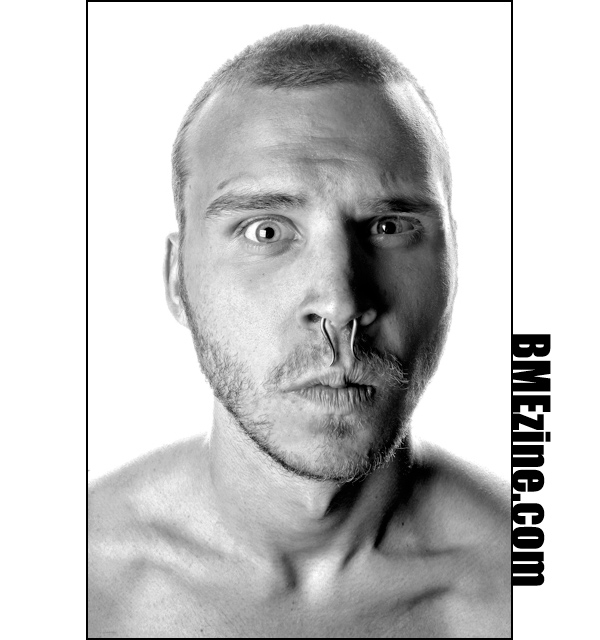
“When i get bored,” Andrew says, “I find weird jewelry or anything else I can find and take really unattractive, boring photos of myself….” Andrew gets his Andy Warhol on, after the jump.
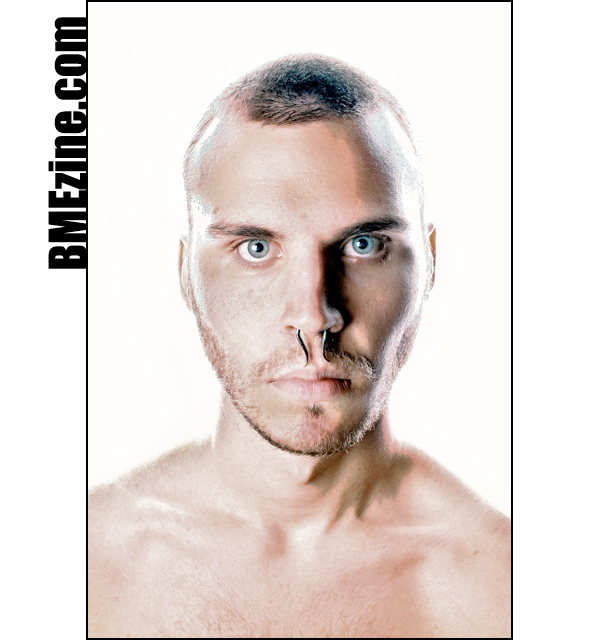

See more in “Septum piercing“ (Nose Piercing)

“When i get bored,” Andrew says, “I find weird jewelry or anything else I can find and take really unattractive, boring photos of myself….” Andrew gets his Andy Warhol on, after the jump.


See more in “Septum piercing“ (Nose Piercing)
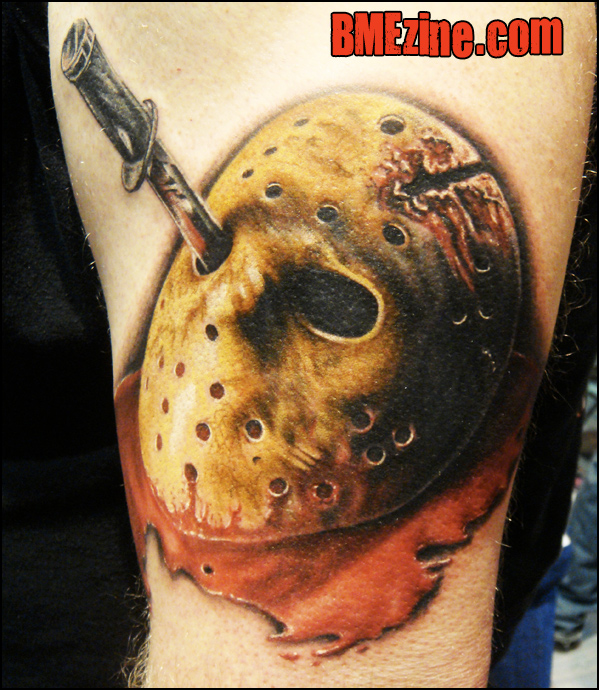
On this Friday the 13th, let us reflect on what we’ve learned from horror movies: You cannot kill Jason—you can only make him angrier. You can send him to New York, you can send him to Hell or you can send him to outer goddamn space…doesn’t matter. You’re just pissing him off. Perhaps it’s time to resign yourself to the fate that awaits you: no matter what you try to do, you are going to be killed by a psychotic hell-demon in a hockey mask, and tough shit.
(Tattoo by Billy Toller at Cherry Bomb Tattoos from New Port Richey, Florida, and the 2009 Philadelphia Tattoo Arts Convention.)
Well, quite a whirlwind of a week this time around, no? Let’s refresh our memories:
– We spoke with Mike Beer, he of the numerous wholly tasteless tattoos. Reactions, as usual, were mixed at best. Evidently, not everyone is ready for “rape time.”
– Atlanta kisses some ass (in the form of a tribute tattoo) to get an apprenticeship with Sean Philips. Mercifully, it worked.
– There is a damn eyeball in that guy’s armpit!
– We all told some great stories about getting our septums pierced.
– The Flying Pink Sausage entered our lives.
– We learned a simple lesson: Money talks and bullshit walks.
– Alice got naked in the snow, just because.
– Nacho’s first suspension was a complete success.
And that’s it for us today, folks. We’ll be around over the weekend though, as per usual. Sorry about no podcast this week—there were some scheduling conflicts with one great guest we had lined up, but we should be getting in touch with him in the next couple of days, so don’t you worry. At any rate, stay safe, have a good weekend, and as always, thank you for your continued support of BME.
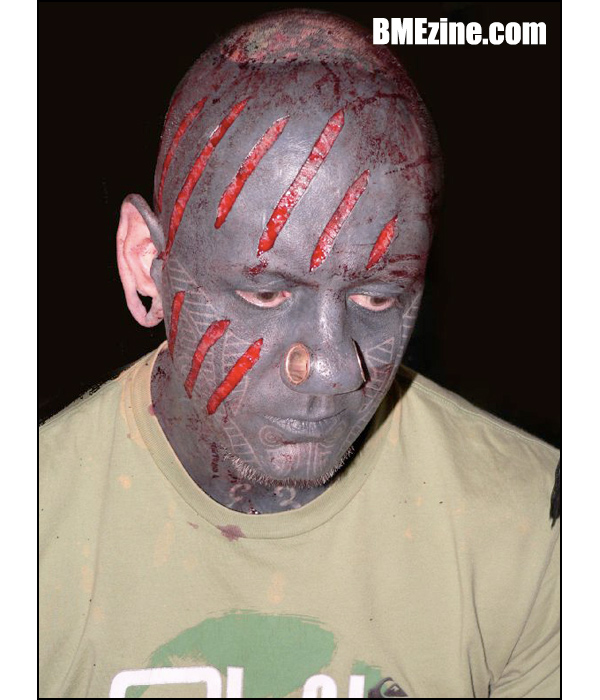
I have to admit, for a split second when I saw these shots of Reece’s facial cuttings by Iestyn, my thought was, “When did Lucky Diamond Rich stretch his nostrils?!” The full-facial black tattoo is pretty high on the list of radical transformations a person can undergo, but when it’s well executed (as it certainly is in this case), the result is really wonderful, I think, and I’m very curious to see how these healed scars add to Reece’s appearance! Some procedural shots after the jump.
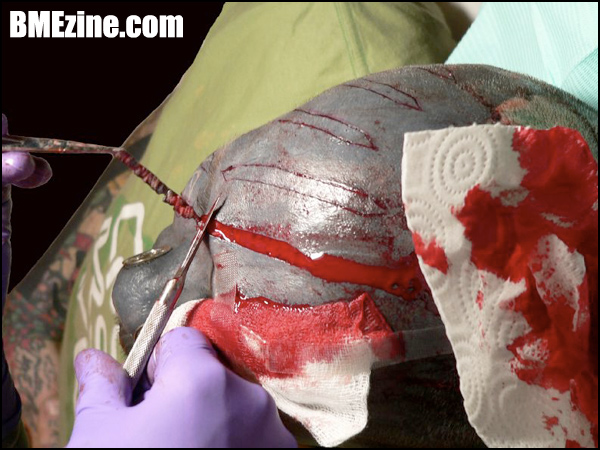
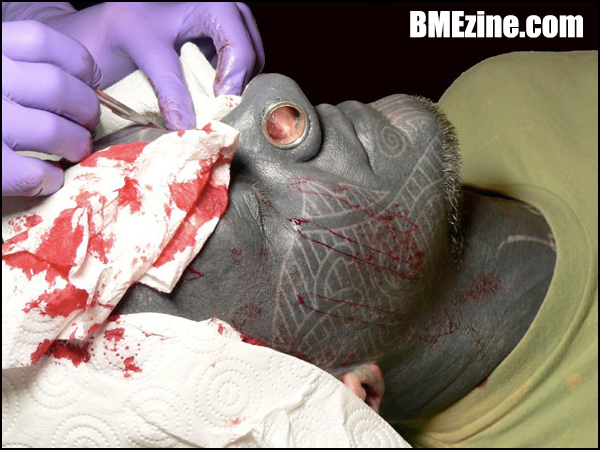
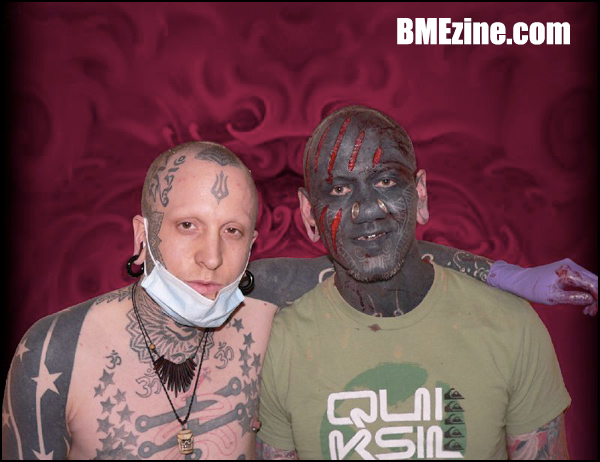
(Scarification by Iestyn at Diamond Jack’s in London, England.)
See more in “Absolute Scarification By Iestyn“ (Scarification)
Welcome to BME’s Big Question! In this feature, we ask a handful of the community’s best and brightest piercers, tattooists, heavy mod practitioners and shop owners for their opinion on one question or issue that’s affecting the body modification community. Many, many thanks to all of the contributors.
If you’d like to be a part of future editions, or if you have an idea for an issue or question you’d like to see addressed, please e-mail me.
This week’s topic comes (and features follow-up questions) from Rachel Larratt:
* * *
 |
I’ll step up to bat with this one.
I hate microdermals with a capital H. I think that while they do offer some possibilities that haven’t been seen before as far as placement and jewelry styles, they are problematic, hard to successfully heal for the long haul, and are just an all-around hassle. I see a lot of them reject and leave pretty nasty scars, because most of the time the client isn’t looking at it on a regular basis (because of its weird placement) to see if anything is wrong with the piercing. I see a lot of them with massive piles of shmutz built up around them for the very same reasons. People don’t tend to view them as “permanent” at all. It’s something to get done now, like an earlobe or nostril, and there is no forewarning about the issues that arise with them from most piercers. When they started to get huge, I admit, we got on the bandwagon, but we have certainly backed off on our enthusiasm with them since watching issues arise. This past month, Vibe magazine had a blurb about microdermals in their fashion issue. It showed a piece on a girl’s side that we did, but what it didn’t show was me resetting that sucker back in there two weeks prior to the shoot because it had been shifting outwards. I know that there are a lot of people gung-ho about them, and they can be fun, but I think they should be viewed much like surface work with a more permanent edge. |
 |
I was leaning towards a negative opinion of them a few months back, but then I started experimenting with longer stem lengths and now things are going a lot smoother. I’ve done about 250 of them over the last 18 months, I’d say the first 200 were 3/32″ rise, no matter the location. I was getting some tilting, and the occasional failure, but still maybe a 60-70 percent flat heal success rate. I think out of that initial 200 I personally removed maybe 15, and a few were cut out by other shops. Now with the 1/8″ and 5/32″ stems I haven’t had a single significant tilt or failure in about five months. The only ones I’ve taken out have been for work reasons, or people just not wanting them.
[Ed. note: Ryan adds, “I just checked my numbers on past microdermal orders and I’m under on my guess for how many I’ve done, but the success rates are still pretty accurate.”] A big issue about them is removal. I’m the only shop in my area that takes them out without using a scalpel. I just use a needle and micro surgical hook to take them out without enlarging the stem hole at all. A lot of people are terrified of trying them because they think they have to get them cut out if they fail. Overall I’m a big fan of them and I try to push people towards those over surface piercings for all nontraditional surface placements. With how easy they are for me to remove I don’t even refer to them as permanent. I just call them semi-permanent and offer future removal for free for any I’ve installed. |
 |
Does anyone else offer free removal as standard practice with a microdermal?
Microdermal rejection scars look fairly extensive from the photos on BME. Do you suggest to clients the immediate removal at the first signs of rejection or do you generally try to reseat the microdermal? In what situations have you refused to do a microdermal? |
 |
I’ve tried re-seating once or twice but now I think it’s just pointless. And I usually tell people that if they can see the foot through the surface and there is any redness it’s time to remove it before you get an ugly scar. But if I take them out early I get barely any scar at all.
I only refuse if the skin is too delicate to support the jewelry—areas like the inner wrist or high anti-eyebrows. Or areas where you get a lot of friction, like low hip placements. |
 |
I have a pretty high success rate with microdermals as well. In a lot of cases I think they are a much better option than surface piercings. However, I think it is the responsibility of the piercer as a professional to go over the risks and make sure the client understands them. A lot of people make a big deal out of their “permanence,” but honestly, removal isn’t that hard. Like Ryan said, they don’t need to be cut out with a scalpel, and a lot of the time I can remove them without even using a needle. Scarring really isn’t anything major with these and it’s a lot less than you would get with a rejecting surface bar.
The only area I’ve seen consistent problems with these is along the collar bones, especially more towards the shoulder. I won’t even do them in that area anymore. Most of the ones I take out now aren’t because of rejection, it’s because the person didn’t want them anymore, or, in most cases, it’s because they were done with inferior quality jewelry. I always remove them free of charge since it’s something the client can’t do themselves, and I don’t want them trying to. I’ve done these in a lot of different areas. A lot of my friends, including my girlfriend, have some that are over two years old now. These are in places like the lower back, sternum, anti-eyebrow area and above and below a navel. I have re-seated some that were not that old, and they healed up fine. I think this really only works if the piercing is still fairly new. Scarring keeps coming up, but honestly I haven’t seen any real scarring from these at all. |
 |
I’ve had a 50/50 success rate with re-seating ones that are tilting; some work, some don’t. The areas I see the biggest problems are the back of the neck and cleavage, and the shoulder is a troublesome area as well, like John said.
We generally remove them for free, unless they were done elsewhere. I don’t cut them out either, just a little massage usually does the trick, although the feet with the big hole…those are a a lot tougher to remove, and sometimes need to be helped out with a needle. As for scarring, the worst I see tends to be on the rejecting nape placements. Lots of buildup with those, not pretty. Are there any other placements you guys shy away from? We don’t do the thin-skinned areas Ryan mentioned, or hands or feet—too much trouble. |
 |
I do a lot of microdermals, and I also try to talk people into them instead of surface piercings when they come in for something like a sternum, anti-eyebrow, etc. I rarely take any out because of rejection—mostly I remove them because of issues at work/school, or the person just doesn’t want them anymore. I’d say from what I’ve seen we have about an 80 percent success rate with them.
I offer free removal if they were done at my shops, and sometimes even if they weren’t. There are a lot of shops around here that use the horrible ones made in Thailand/Korea/wherever it is that sell them for $1 or less. When educating people about them and why they aren’t working out for them, most of the time they understand what I’m saying and come back to get them done with the proper jewelry in them, so when it seems like a situation like that, I don’t charge for the removal. When I remove them, I just massage the tissue until the heel can pop out, then pull them out. Sometimes I have to slide a needle underneath them to cut through the scar tissue that grows through the holes, but that’s only about 50 percent of the time. I’ve seen some scarring, but normally less than from surface piercings or other rejecting piercings. If someone wants to keep the microdermal when it seems to be rejecting I’ll try re-seating them if there isn’t a lot of scar tissue built up already, or if there is, then I have them wait a few weeks till it goes down and can be re-done. The place I’ve noticed having the most problems with tilting out and needing to be re-seated more often than anywhere else is the lower-center forehead, the “third eye” position, or closer to the eyebrows there as well. I think this is due to all the movement in the area, so I warn people that come in for those before doing them. |
 |
There are several variations: solid base, one hole, two holes and three holes. Which design do you generally prefer?
|
 |
I prefer the Anatometal pieces with one large hole. I’ve used the IS and Wildcat pieces as well; IS are my second choice. The bases on the Wildcat pieces are a little too thick for my liking, and the finish isn’t as nice as the Anatometal and IS pieces.
The Anatometal pieces tend to heal much better and more securely in place in my experience, however that does make them slightly harder to remove than the others. |
 |
I’ll chime in “thumbs down.”
I was really excited when I first saw them. I had a pair of them put in my forehead by Didier at Enigma a few years back and it didn’t take me long to start changing my mind. I’m also not a huge surface piercing fan to begin with so I guess I should have seen that coming. The whole issue of removal was a great deal more complicated when people hadn’t removed them a whole lot. I don’t like doing them so generally I pass and book an appointment for the boss, but I’ve gotten very good at taking them out. The biggest problems I see with healing is people’s inability to remember they have them: catching them, snagging them. I had one guy that had lost the top of an anchor he had in his nape while on vacation. The shop he went to put a 6 mm steel ball on the jewelry and he then spent a week in bed till he came to see me—the thing had grown out completely sideways. But, curve balls aside, if someone is coming in to take an anchor out, removing the threaded end and attaching a threaded taper, gently enlarging the pocket under the tissue by stirring the jewelry a bit works pretty well for me. It feels a lot like losing a tooth; just kinda wiggle it until those threads let go. As Meg said, the large hole model is a little trickier. |
 |
That’s how I take them out too, Stephen, although remember that one disaster you had to remove when you were guesting here? That thing was so scary!
|
 |
Yeah, that was one of the authentic “surface anchors” that has one half bent like a closed staple and an arm that holds the gem. It was the first time I had seen one and was a little puzzled. You can’t just wiggle those things out because of the shape; it’s similar to the old bar trick of folding a drinking straw in half and inserting it into the neck of a bottle to pick it up. For that one, I actually used the bevel of a needle to widen to hole enough to take out. That poor girl was completely freaked out.
That’s another thing about anchors: I think there’s just as many people who understate what can happen with anchors as those who get everyone all wound up about scalpel removal. I think it’s important to inform the client of possible risks without downplaying them or scaring the crap out of them, and also, to recognize the capabilities and limitations of anchors—meaning, they open options but they aren’t foolproof. |
 |
As for the base I prefer (back to Rachel’s question), I like the IS ones for ease of removal, but the Anatometal ones for staying power. Those suckers are tough to get out though. I’ve got a client that got a “Madison” placement dermal, and it rejected three times with the IS one. I popped in an Anatometal one, and it’s going strong at about eight months now.
I’m pretty thorough when I explain the hows, whys and removal aspects of them, but not everyone understands, even after a talking-to. People see pictures of all this crazy stuff done with them (like eyelids) and then get irritated when they find out that they can’t just take them out when they want to and put them back in like a standard piercing. My big question for all of you is how long do you tell your clients they take to “heal”? I tell mine that they will settle in after a few weeks to a month, but can never really be called “healed,” as there is never gonna be a neat little dry pocket around that base. Also, what is your aftercare suggestion for them? Do you have your clients bandage them initially? |
 |
I tell people the “initial healing period” is about a month, but that it can take a few extra weeks to toughen up. I also tell them to wait at least six weeks to come in for an end-piece change, or to wait three months if they want to do it themselves. I cover all mine with a Nexcare waterproof bandage and tell them to leave it on for anywhere from one to three days depending on the location.
|
 |
Microdermals hit about the time that I started transitioning out of piercing so I’ve only done a handful. So, it’s really hard for me to formulate much of an opinion. [Ed. note: But that’s never stopped you before!]
As for my like or dislike of dermal anchors…personally, I like them. Less invasive than traditional larger transdermals and if well-placed they hold up infinitely better than surface piercings. If anyone has ever read one my rants you’ll know I’m not a big a fan of surface piercings…but I don’t want to get too far off-topic. As for removal, I’ve helped with a couple, but that’s usually because Allen gets roped in when it requires brute force. I’m definitely not shy about getting out “stuck” jewelry. As for price, well, I’m sure everyone has their own opinion. Me, I think all removal and most general maintenance should be free, no matter who put in the jewelry. It’s been my experience that people normally tip really well for a free service. Plus, it’s good for business and ultimately good for the community. Each crappy piercing that walks down the street or appears in the media is a blow to the entire piercing industry…and you know how it is. There is a certain satisfaction about fixing someone else’s mistakes that really makes doing your job worthwhile. |
 |
Price is a good point. What are you guys charging to do microdermals? Do you include the foot in the price?
Our cost is $75 for the service, which includes the base, then the additional cost is what frontal you want on it—disks or gems or whatnot. And we take them out for free. |
 |
I charge $80 for one and $60 for each after (in the same session on the same person) with a disc on them. If they want gems, etc., the price goes up depending on the end.
|
 |
I charge $70 for one, $130 for a pair, $60 each for three or more. Price includes standard disc ends; gemstone or alternate ends are an additional $10-$15 each. Free removal if I installed it, $20 if it was put in somewhere else.
I charged $80 when I was first doing them, but now with IS lowering their prices I can’t see charging that much. I only charge $65 for a surface piercing with an Anatometal flat surface bar and those cost twice as much as microdermal jewelry. |
 |
I charge $75 for one with a flat disc, more if they want a gem. Each additional one done after that I take a little off the price. Free removal whether I installed it or not.
|
 |
I believe were running $50 for a basic disc, $75 for gems.
|
 |
Since we’re talking microdermals, I’ve had two different people come in over the last two days that both had microdermals done on their sternums at a different shop in Syracuse. One girl’s fell out within a day, and the other girl’s was sticking way out and was about to fall out. I’m not sure what method was used to put these in, but there was a huge pocket made. In the one that was still in, there was a gaping hole around the post of it. The rise used on both of them was far too long for these girls as well.
I think most people in this forum are probably getting somewhere in the 85-90 percent success rate with microdermals, but I think it’s really important to remember that we aren’t the majority of piercers out there. There are going to be a lot more piercers only getting 50 percent success rate or maybe 75 percent at best. This could be from any number of things: using poor quality jewelry, poor installation technique, poor aftercare, poor placement, or just not really understanding what a microdermal is. My point is, with piercing, but especially microdermals it is important for the client to do their own research first. It is also important for the practitioner to make sure they fully understand microdermals, and how they work. |
What do you think? Let’s hear it in the comments.
Please consider buying a membership to BME so we can continue bringing you articles like this one.
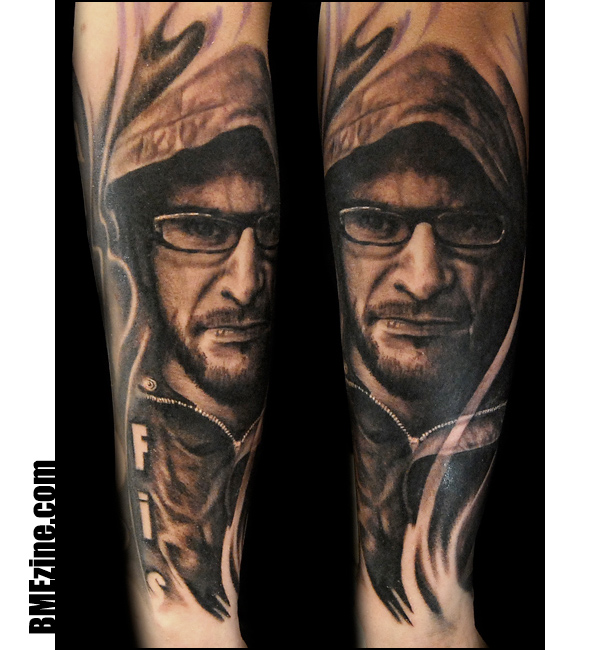
I admit that my knowledge of Polish avant-garde hip-hop is woefully underdeveloped, but nonetheless, I can certainly appreciate this portrait of one of the ostensible pioneers of the genre, Bartosz Waglewski/Fisz, nicely rendered by Tofi at Art-Line in Rybnik, Poland. After the jump, his older brother, Emade, a hip-hop producer as well.
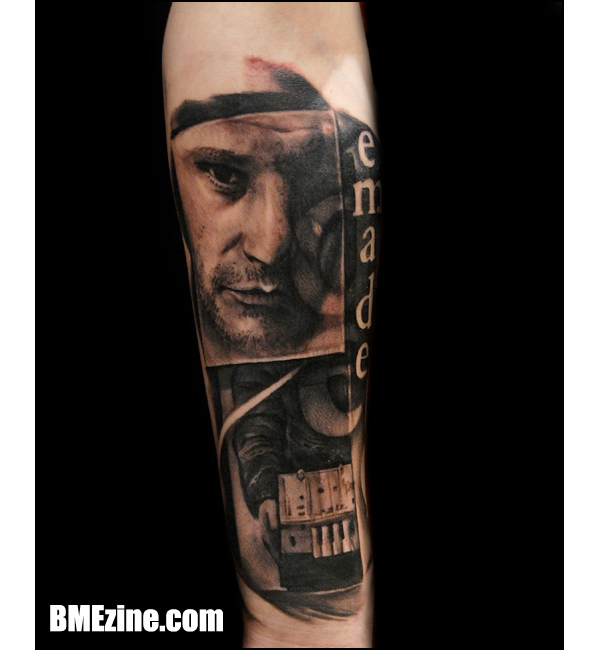
See more in “Music Tattoos“ (Tattoos)

Good morning afternoon (lousy Internet), ModBloggers! Here we have famous_punx, hanging out at a photo shoot for his old band, Radio City Riot. Another shot after the jump.
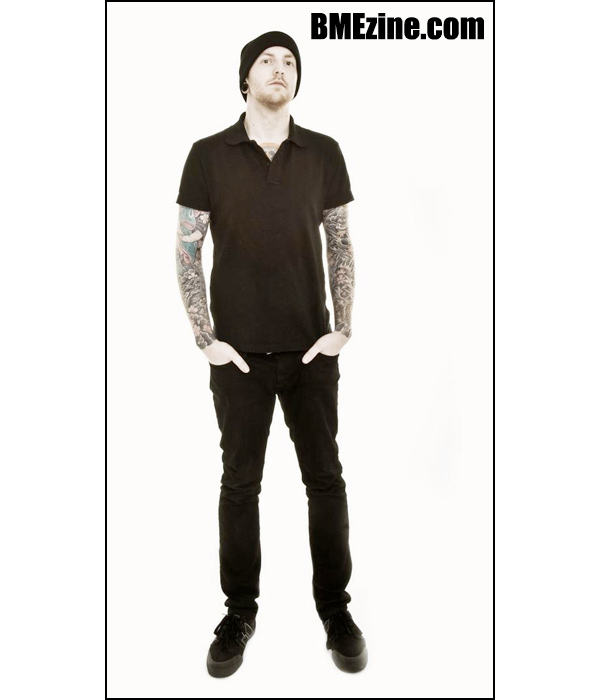
(Tattoos by Ade in Brighton, UK. Photos by Al Overdrive.)
See more in “Oriental-style Tattoos“ (Tattoos)
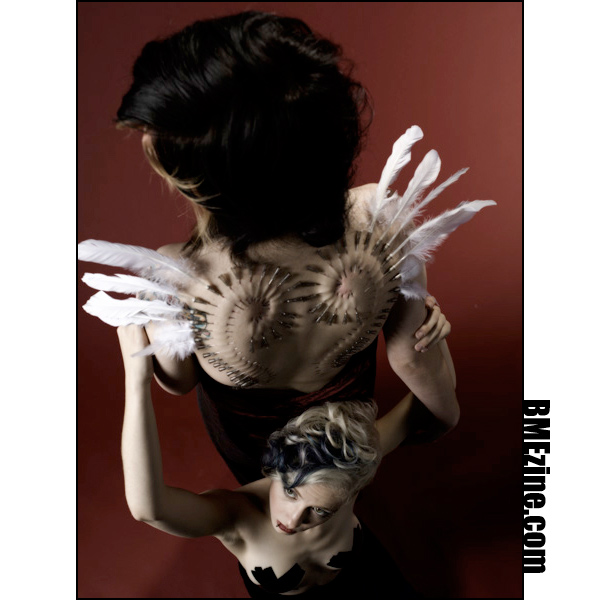
This play piercing photo comes from Cris Black at Aces and Eights, who explains:
did this play piercing in Norcross, Georgia, on a client/friend of mine named Heather (on whose chest I’ve done microdermal implants). The original idea was to have both girls (Heather and Hailey) to have wings, but after seven needles were placed, Hailey passed out, so we had to make do with only the one girl. The piercings only took about 30 minutes, the photo shoot that followed took about six hours; 74 22-gauge needles. This was the first play piercing Heather had ever been a part of and she’s already asked for more—I think she’s hooked.
See more in “Ritual and Play Piercing“ (Ritual)
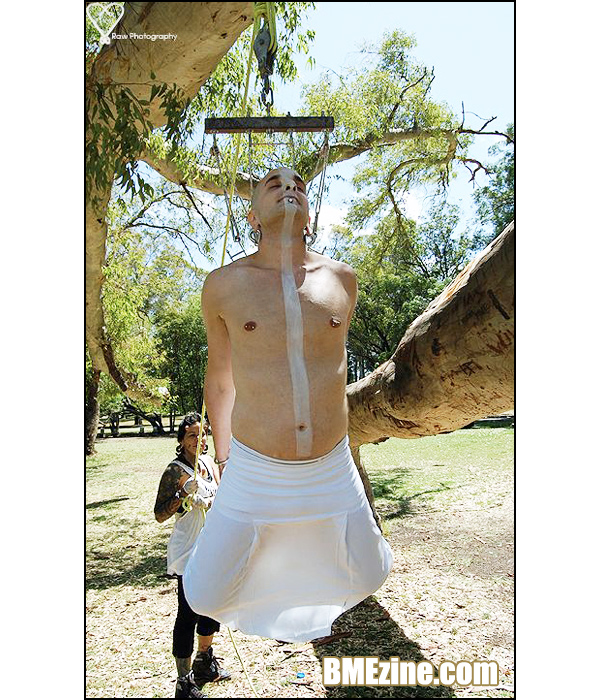
Nacho suspension! Eh? Eh?
**gongggggg**
ANYWAY, here we have the aforementioned Ignacio’s first suspension in Montevideo, Uruguay, being attended to by the lovely La Negra, who basically lives on ModBlog. As far as first suspensions go, this one seems like it got a lot of the parts just right. A few more shots after the jump.
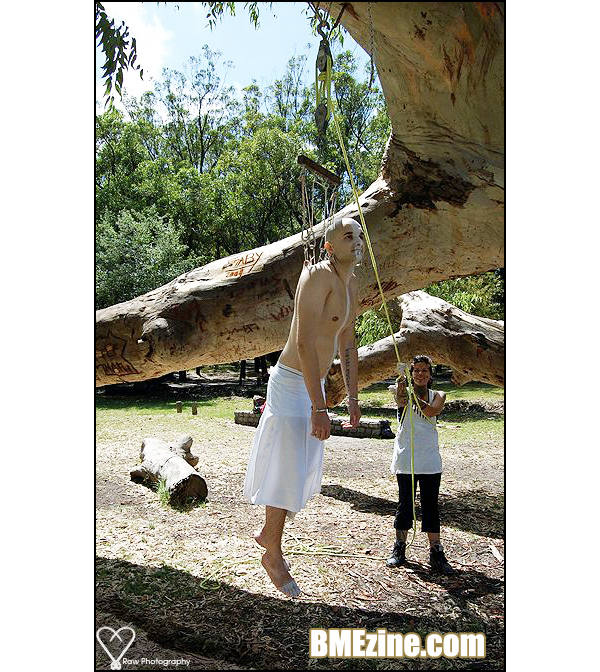
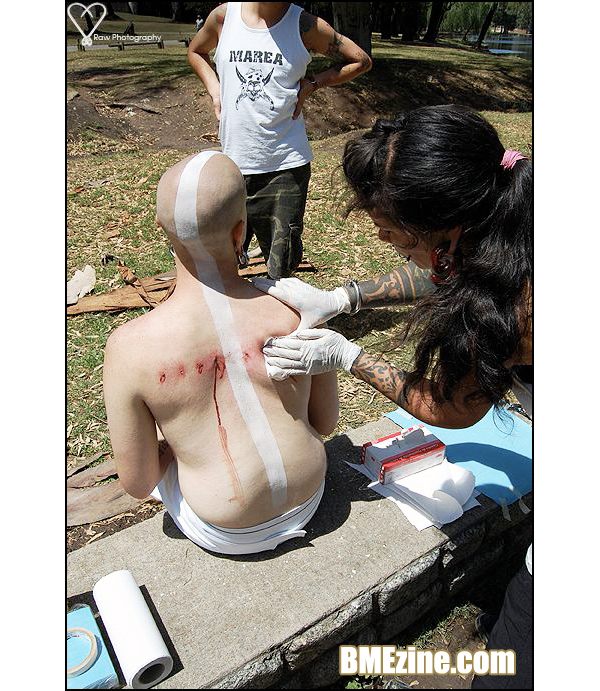
(Photos by María Pérez/Raw Photography.)
See more in ““Suicide” Suspension“ (Ritual)
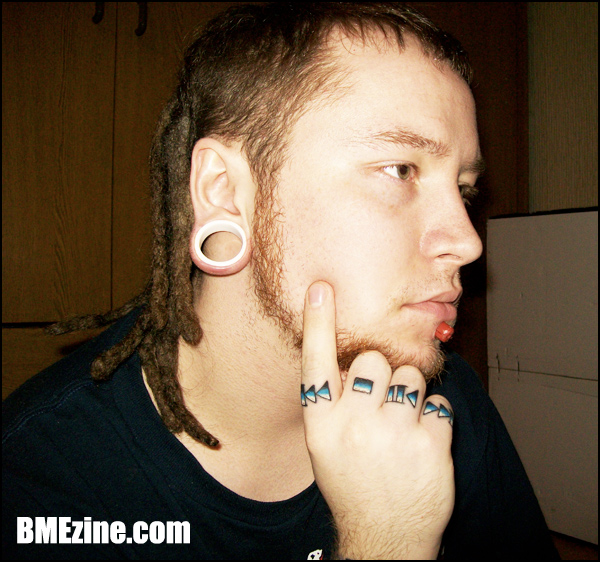
Yep, we’ve got “Play” and “Stop,” “Fast Forward” and “Rewind” … fine, I’ll ask: What do you press to eject?
(Tattoo by “Jesus a.k.a. Homefreak” in Yekaterinburg, Russia.)
See more in “Hand Tattoos“ (Tattoos)

Alice has been featured on these here Internets once or twice before, and with good reason! Easy on the eyes, heavy blackwork sleeves, multiple excellent pieces by the esteemed Xed le Head and, apparently, total imperviousness to the cold and snow. Warning! Naughty bits, after the jump.


See more in “Modded Women“ (members only)